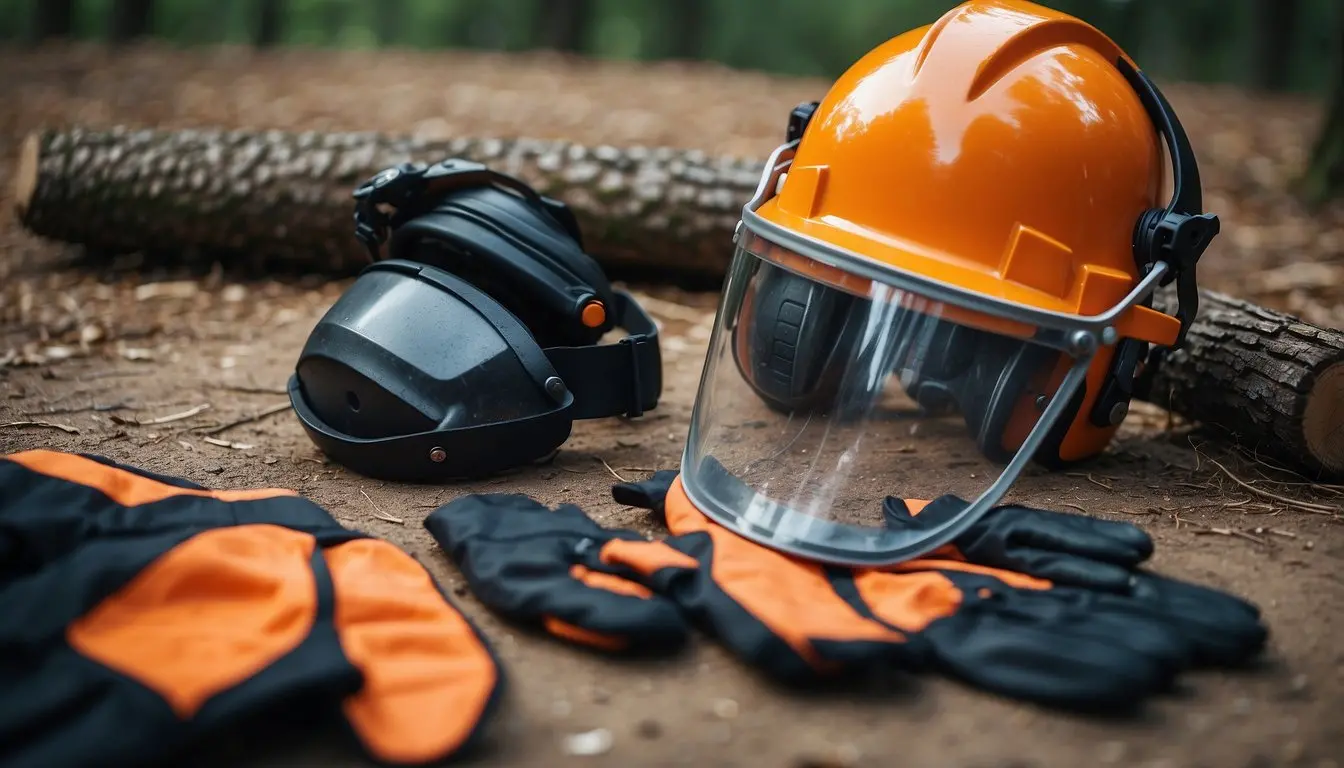
Gardening can be a fulfilling and rewarding activity, but it can also be dangerous if proper safety measures are not taken. One of the most important tools in a gardener’s arsenal is a chainsaw, but it can also be one of the most dangerous. Chainsaws can cause serious injuries like cuts, amputations, and even death if not used correctly. Therefore, it is essential to understand the risks and hazards associated with chainsaw use and to take necessary precautions to protect yourself.
One of the most important precautions you can take is to wear appropriate chainsaw safety gear. Chainsaw safety gear is designed to protect you from the various hazards associated with chainsaw use, including flying debris, noise, and vibrations. In this article, we’ll provide a complete guide to chainsaw safety gear for gardeners, including an overview of the essential safety gear, how to choose the right gear for different gardening tasks, and how to maintain and care for your safety gear.
Key Takeaways
- Understanding the risks and hazards associated with chainsaw use is essential to protecting yourself while gardening.
- Essential chainsaw safety gear includes head protection, upper body protection, lower body protection, and footwear.
- Choosing the right chainsaw safety gear for different gardening tasks and maintaining it properly can help prevent injuries and accidents.
Table of Contents
Understanding Chainsaw Risks and Hazards
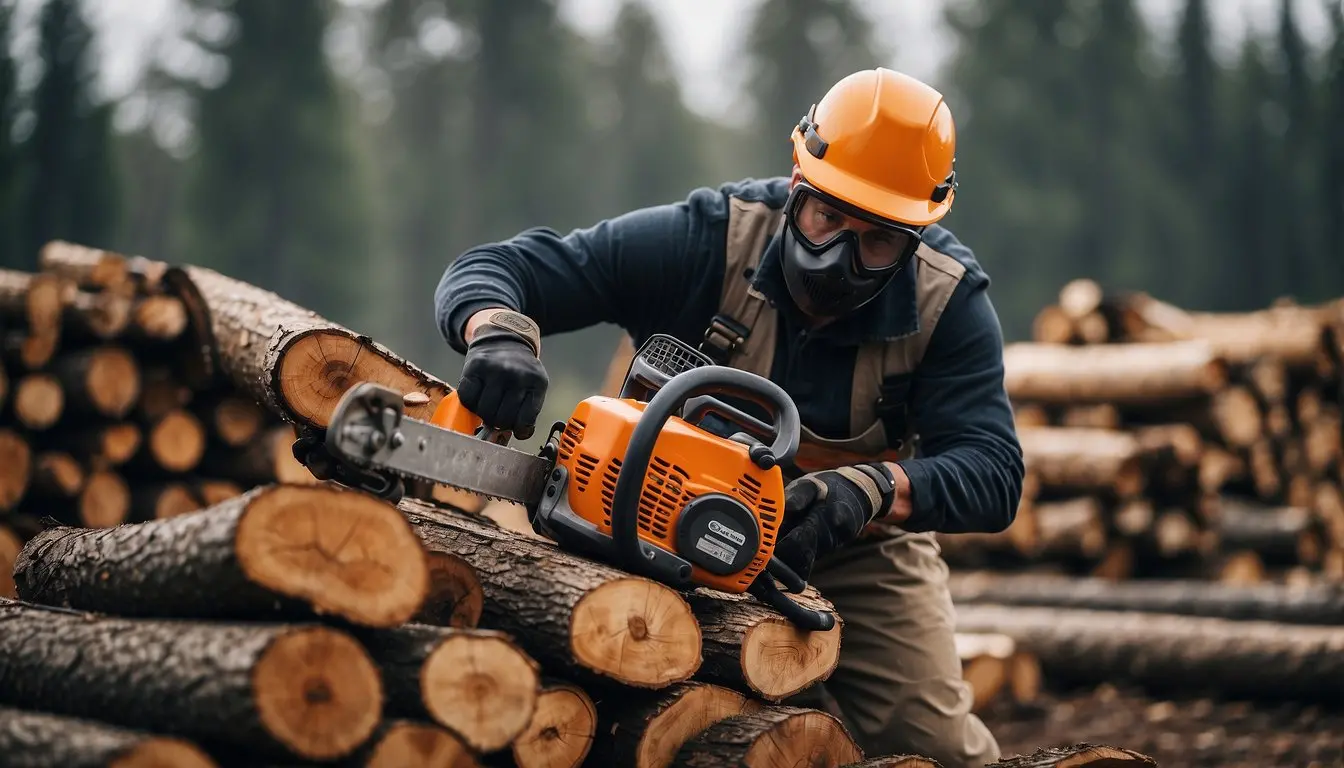
Chainsaws are powerful tools that can cause serious injuries if not used properly. It is essential to understand the risks and hazards associated with chainsaw use to protect yourself and those around you. Here are some of the most common risks and hazards you should be aware of:
Kickback
Kickback is the most common cause of chainsaw injuries. It occurs when the chainsaw’s bar tip comes into contact with an object, causing the saw to jerk back towards the operator. To prevent kickback, always use a chainsaw with a reduced kickback bar and chain, and never use the tip of the bar to cut.
Noise
Chainsaws can produce noise levels of up to 120 decibels, which can cause permanent hearing damage. To protect your hearing, wear earplugs or earmuffs that are designed to reduce noise levels.
Flying Debris
Chainsaws can produce flying debris, such as wood chips and sawdust, which can cause eye injuries. To protect your eyes, wear safety glasses or goggles that are designed to provide impact protection.
Vibration
Chainsaws can produce high levels of vibration, which can cause hand-arm vibration syndrome (HAVS). To reduce the risk of HAVS, choose a chainsaw with anti-vibration features and take regular breaks to rest your hands.
Burns
Chainsaws can become hot during use, which can cause burns if they come into contact with your skin. To prevent burns, wear gloves that are designed to provide heat protection.
By understanding these risks and hazards, you can take the necessary precautions to protect yourself while using a chainsaw. Always wear the appropriate safety gear, follow the manufacturer’s instructions, and never use a chainsaw if you are tired, under the influence of drugs or alcohol, or not feeling well.
Essential Safety Gear Overview
When it comes to using a chainsaw, safety should be your top priority. The right safety gear can make all the difference in protecting against potential hazards and ensuring comfort during extended use. Here’s a list of essential safety gear you should consider before using a chainsaw:
1. Chainsaw Helmet
A chainsaw helmet is a must-have for anyone using a chainsaw. It provides protection for your head against falling debris and also includes a visor to protect your face and eyes from flying wood chips and sawdust. Look for a helmet with a comfortable fit and adjustable straps to ensure it stays securely in place.
2. Chainsaw Gloves
Chainsaw gloves are designed to protect your hands from cuts and scratches while also providing a good grip on the chainsaw. They should be made from a durable material that can withstand the sharp teeth of the chainsaw, such as leather or Kevlar.
3. Chainsaw Chaps
Chainsaw chaps are designed to protect your legs from accidental cuts while using a chainsaw. They are typically made from a heavy-duty material that can stop the chainsaw from cutting through the fabric. Look for chaps with adjustable straps to ensure a comfortable fit.
4. Steel-Toe Boots
Steel-toe boots are essential for protecting your feet from falling debris and accidental cuts from the chainsaw. They should be made from a durable material that can withstand the sharp teeth of the chainsaw and provide good traction on uneven terrain.
5. Eye and Ear Protection
Eye and ear protection are essential for protecting your eyes and ears from flying debris and loud noises while using a chainsaw. Look for safety glasses or goggles that provide full coverage and ear muffs or plugs that provide adequate noise reduction.
By investing in the right safety gear, you can protect yourself from potential hazards and ensure a safe and comfortable experience while using a chainsaw.
Head Protection
When it comes to chainsaw safety gear, head protection is of utmost importance. The head is the most vulnerable part of the body and can be seriously injured by flying debris or a chainsaw kickback. Here are the three types of head protection that you should consider:
Helmets
A chainsaw helmet provides comprehensive protection for your head, face, and ears. Look for a helmet with a built-in face shield to shield your face from flying debris and wood chips. Additionally, ensure it has integrated ear protection, such as earmuffs or earplugs, to reduce noise levels and prevent hearing damage from prolonged exposure to chainsaw noise. A chainsaw helmet is a must-have for any gardener or homeowner who uses a chainsaw.
You can read our chainsaw helmet product review here.
Face Shields
A face shield is an essential piece of chainsaw safety gear that protects your face from flying debris and wood chips. It is an additional layer of protection that can be worn over a helmet or alone. A face shield should be made of impact-resistant materials and should cover your entire face. It should be easy to clean and maintain, and should not obstruct your vision.
You can read our chainsaw face shield product review here.
Hearing Protection
Chainsaws can produce noise levels of up to 120 decibels, which can cause permanent hearing damage if you are exposed to it for prolonged periods. Therefore, it is essential to wear hearing protection when using a chainsaw. There are two types of hearing protection: earmuffs and earplugs. Earmuffs are more effective at reducing noise levels than earplugs, but they can be uncomfortable to wear for extended periods. Earplugs are more comfortable, but they are less effective at reducing noise levels. Choose the type of hearing protection that is most comfortable for you, but make sure that it provides adequate protection.
You can read our chainsaw hearing protection product review here.
Upper Body Protection
When it comes to chainsaw safety gear, protecting your upper body is crucial. Here are the three essential types of gear you should consider:
Jackets
Wearing a chainsaw-resistant jacket can provide a vital layer of protection. Look for a jacket that is made from durable materials such as Kevlar or ballistic nylon. These materials are designed to resist cuts and tears from the chainsaw’s chain and bar. A good chainsaw jacket should also have a snug fit to prevent it from getting caught in the chainsaw.
You can read our chainsaw jacket product review here.
Gloves
Wearing gloves is important to protect your hands from the chainsaw’s sharp chain and bar. Look for gloves that are made from chainsaw-resistant materials such as Kevlar or leather. These materials will help prevent cuts and tears to your hands. A good pair of gloves should also have a snug fit to prevent them from getting caught in the chainsaw.
You can read our chainsaw gloves product review here.
Arm Guards
Arm guards are another important piece of chainsaw safety gear. They are designed to protect your arms from the chainsaw’s chain and bar. Look for arm guards that are made from durable materials such as Kevlar or ballistic nylon. These materials are designed to resist cuts and tears from the chainsaw’s chain and bar. A good pair of arm guards should also have a snug fit to prevent them from getting caught in the chainsaw.
Remember, when it comes to chainsaw safety gear, it’s important to choose high-quality gear that fits well and is made from durable materials. By doing so, you can help protect yourself from serious injury while working with a chainsaw.
You can read our chainsaw arm guards product review here.
Lower Body Protection
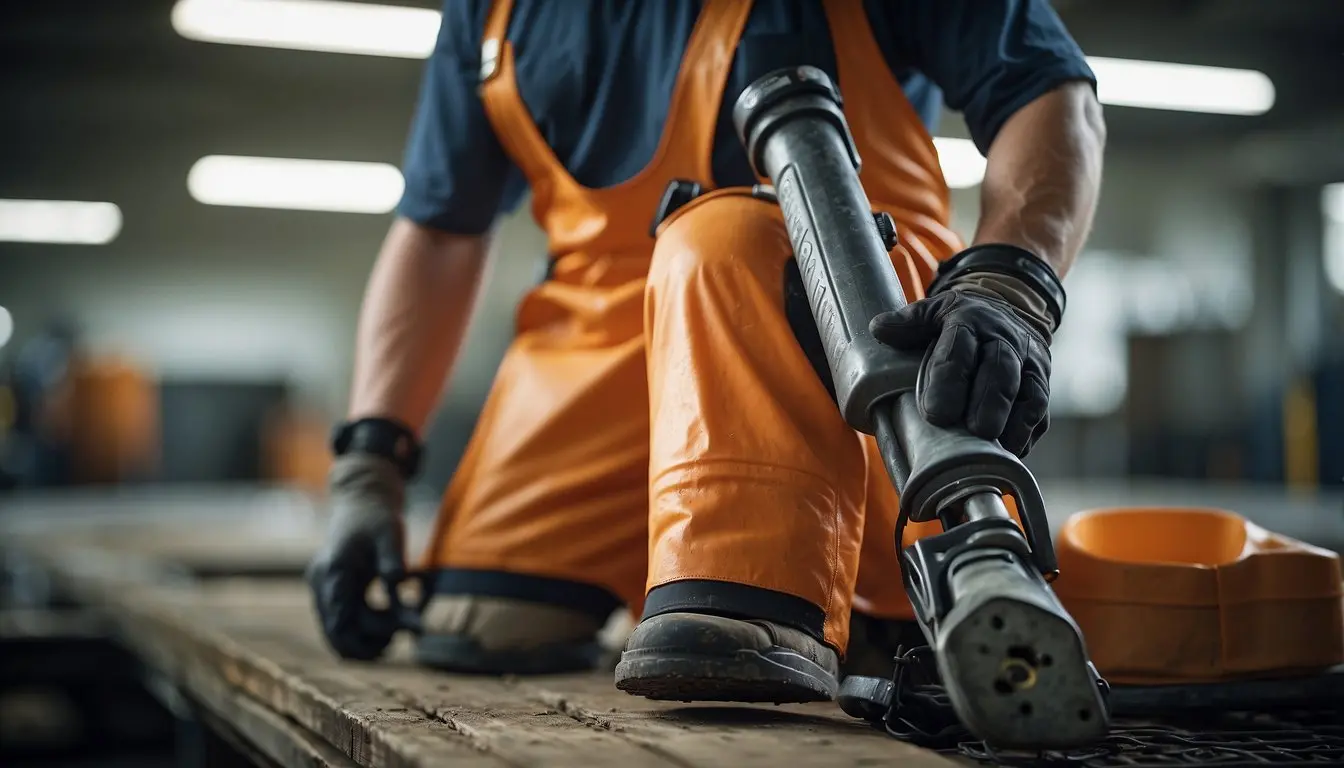
When it comes to chainsaw safety gear, protecting your lower body is just as important as protecting your upper body. Here are some essential items to consider:
Chainsaw Chaps
Chainsaw chaps are a must-have for anyone working with a chainsaw. They are designed to protect your legs from the chainsaw’s chain and bar in case of accidental contact. Chaps are made of multiple layers of cut-resistant material that can stop a chainsaw chain in its tracks.
When shopping for chainsaw chaps, look for chaps that meet the ASTM F1897 standard for leg protection. Ensure that the chaps fit comfortably and snugly over your pants and that they cover your entire leg, from the waist to the ankle.
You can read our chainsaw chaps product review here.
Pants
In addition to chainsaw chaps, you should also wear protective pants when using a chainsaw. Look for pants made of cut-resistant material, such as Kevlar or ballistic nylon. These materials can help prevent serious injuries in case of accidental contact with the chainsaw.
When choosing protective pants, make sure they fit well and are comfortable to wear. You should be able to move freely and easily while wearing them.
You can read our chainsaw pants product review here.
Knee Pads
Knee pads are another important piece of lower body protection. They can help prevent injuries to your knees in case of falls or other accidents while using a chainsaw. Look for knee pads that are comfortable and fit well. They should be made of durable materials that can withstand heavy use.
In conclusion, protecting your lower body is essential when working with a chainsaw. Chainsaw chaps, protective pants, and knee pads are all important pieces of safety gear that can help prevent serious injuries. Remember to choose gear that fits well, is comfortable to wear, and meets safety standards.
You can read our chainsaw knee pads product review here.
Footwear
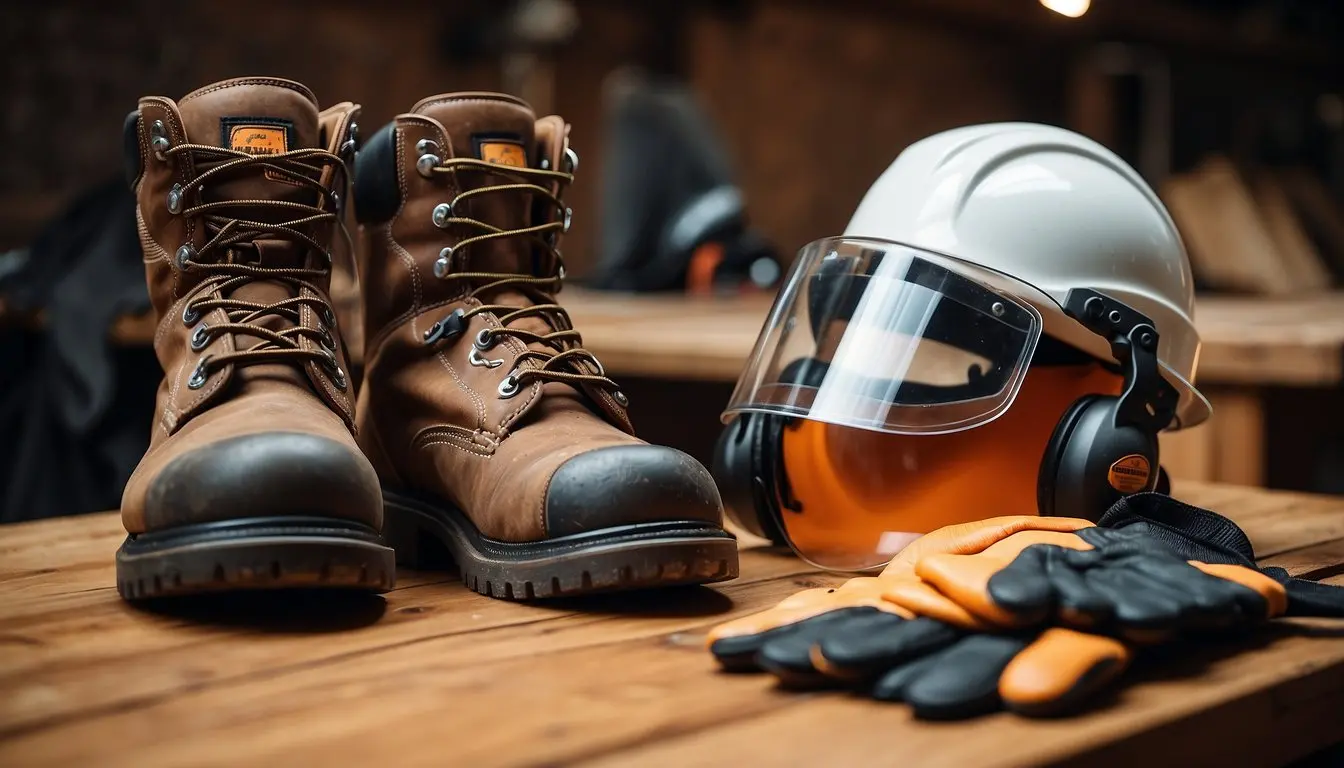
When it comes to chainsaw safety gear, proper footwear is essential. You want to choose boots that are sturdy and provide protection for your feet from falling debris and the chainsaw itself.
Boots
Look for boots that have a steel toe to protect your toes from being crushed by heavy objects. Boots with a thick sole will also help absorb shock and prevent slipping on wet or uneven surfaces. It’s important to choose boots that fit well and are comfortable to wear for long periods of time.
You can read our chainsaw safety boots product review here.
Choosing the Right Gear for Different Gardening Tasks
When it comes to gardening tasks involving a chainsaw, it is essential to choose the right gear to ensure your safety. The type of gear you need depends on the task you are performing. Here are some guidelines to help you choose the right gear for different gardening tasks:
Chainsaw Chaps
If you are using a chainsaw to cut down trees or large branches, chainsaw chaps are a must-have. Chainsaw chaps are designed to protect your legs from the chainsaw’s sharp teeth in case of an accident. They are made of tough, durable materials that can withstand the impact of the chainsaw. Look for chaps that are comfortable to wear and have adjustable straps to ensure a snug fit.
Chainsaw Gloves
Chainsaw gloves are another essential piece of gear for gardening tasks involving a chainsaw. They are designed to protect your hands from cuts, scrapes, and other injuries. Look for gloves that are made of durable materials and have a non-slip grip to ensure a secure hold on the chainsaw.
Eye and Ear Protection
When using a chainsaw, it is essential to protect your eyes and ears from debris and noise. Wear protective glasses or goggles to shield your eyes from flying debris, and wear earplugs or earmuffs to protect your ears from the loud noise of the chainsaw.
Footwear
Wearing the right footwear is crucial when using a chainsaw. Look for boots that are made of durable materials and have a non-slip sole to ensure a secure grip on the ground. Avoid wearing sandals, flip-flops, or any other open-toed shoes.
Head Protection
Finally, consider wearing a hard hat to protect your head from falling debris. A hard hat can also protect you from branches and other objects that may fall from the tree you are cutting.
In conclusion, choosing the right gear for different gardening tasks involving a chainsaw is crucial to ensure your safety. Always wear chainsaw chaps, gloves, eye and ear protection, appropriate footwear, and head protection when using a chainsaw.
Maintenance and Care of Safety Gear
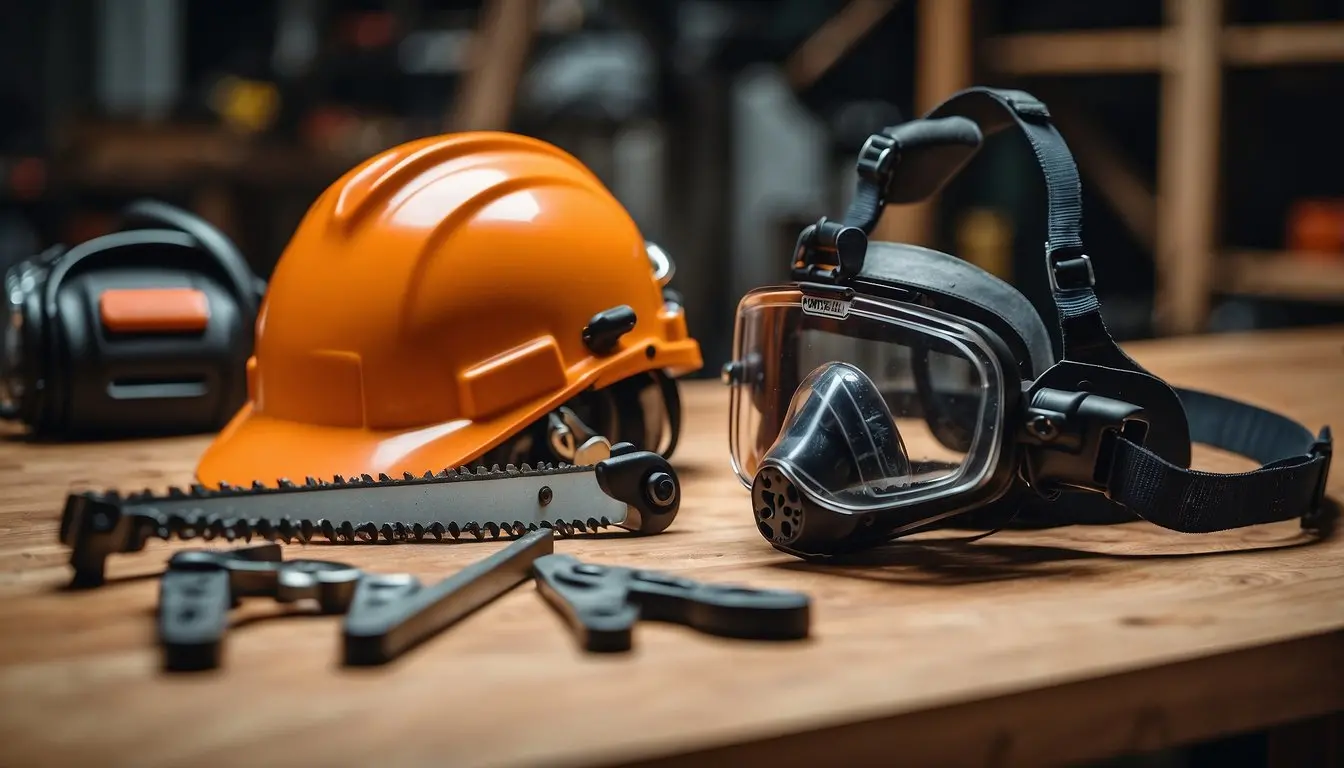
As a gardener who uses a chainsaw, it is important to keep your safety gear in good condition to ensure maximum protection. Here are some tips on how to maintain and care for your chainsaw safety gear.
Gloves
Gloves are an essential part of your safety gear when using a chainsaw. Leather gloves are the best option as they provide good protection and grip. Make sure to check your gloves for any holes or tears before each use. If you find any damage, replace them immediately.
Eye and Ear Protection
Your eyes and ears are vulnerable to damage when using a chainsaw. Always wear safety glasses or goggles to protect your eyes from flying debris. Ear protection such as earplugs or earmuffs can also help prevent hearing damage from the loud noise of the chainsaw.
Chainsaw Chaps
Chainsaw chaps are designed to protect your legs from accidental cuts while using a chainsaw. They are made of special fibers that will stop the chainsaw from cutting through the material. Make sure to check your chaps for any damage before each use. If you find any cuts or tears, replace them immediately.
Helmet
A helmet with a face shield and ear protection is a must-have when using a chainsaw. Make sure to check the helmet for any damage before each use. If you find any cracks or dents, replace the helmet immediately.
Maintenance
Proper maintenance of your safety gear is important to ensure it is always in good condition. Follow the manufacturer’s instructions for cleaning and storing your safety gear. Make sure to check your safety gear for damage before each use. If you find any damage, replace the gear immediately.
By following these tips, you can ensure that your chainsaw safety gear is always in good condition and provides maximum protection while using a chainsaw.
Emergency Preparedness and First Aid
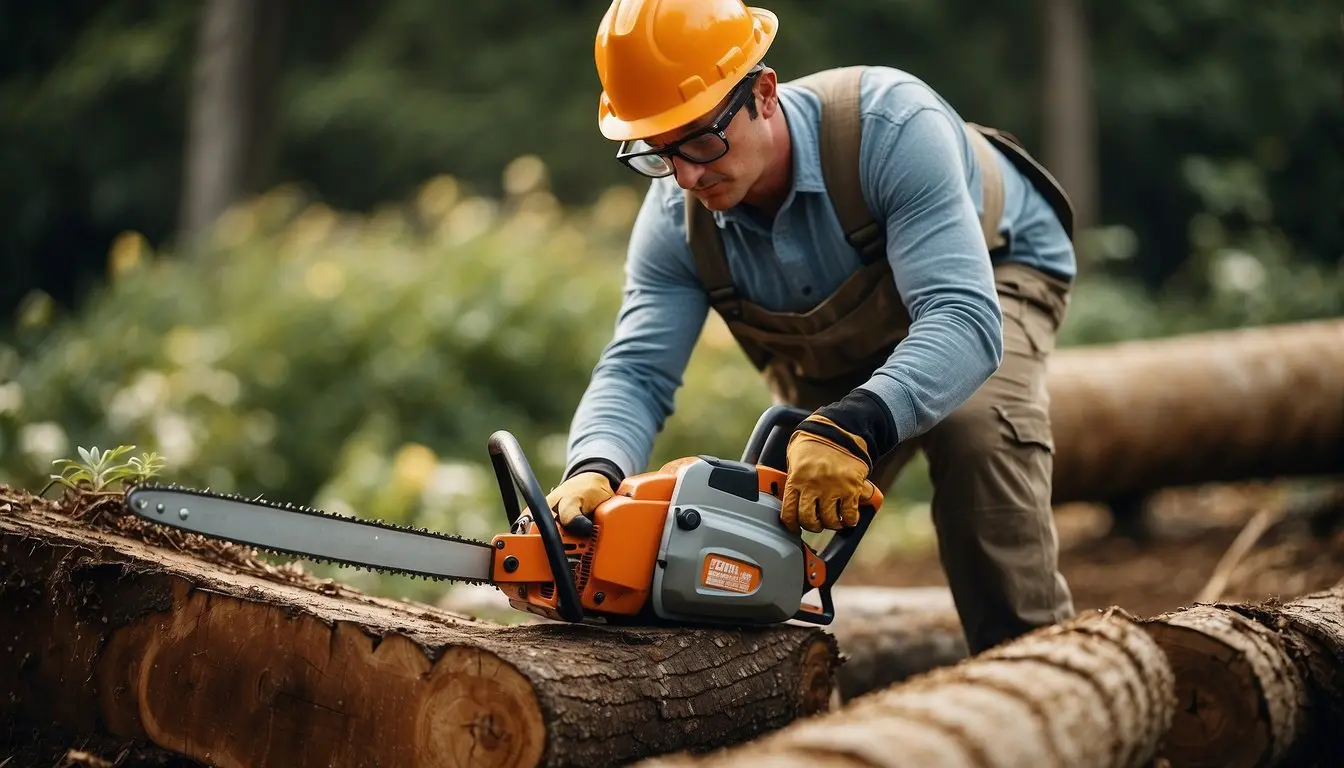
When working with a chainsaw, it’s important to be prepared for emergencies and know how to administer first aid if necessary. Here are some essential tips to keep in mind:
Emergency Preparedness
- Always carry a fully charged mobile phone and a whistle in case you need to call for help.
- Make sure someone knows where you are and what you’re doing before starting work.
- Keep a first aid kit nearby and know how to use it.
- Identify potential hazards in the work area and take steps to eliminate or minimize them.
- Have an emergency plan in place in case of an accident, and make sure everyone on the job site knows what to do.
First Aid
If an accident does occur, it’s important to know how to administer first aid. Here are some basic steps to follow:
- If someone is injured, stop the chainsaw immediately and assess the situation.
- Call for emergency medical help if necessary.
- If the injury is minor, clean the wound with soap and water and apply a sterile bandage or dressing.
- If the injury is more serious, apply pressure to the wound to stop bleeding and keep the injured person calm and still until help arrives.
Remember, the best way to prevent accidents is to follow proper safety procedures and wear the appropriate safety gear. In the event of an emergency, being prepared and knowing how to administer first aid can make all the difference.
Frequently Asked Questions
What are the essential pieces of personal protective equipment for chainsaw operation?
When operating a chainsaw, it is crucial to wear the appropriate personal protective equipment (PPE). The essential pieces of PPE for chainsaw operation include a helmet with a face shield and ear protection, chainsaw gloves, chainsaw chaps or pants, and boots with steel toes and non-slip soles. These items provide protection against potential injuries to the head, face, ears, hands, legs, and feet.
How do chainsaw chaps provide protection to users?
Chainsaw chaps are designed to provide protection to the legs in case of a chainsaw kickback. They are made of specialized materials that can stop a chainsaw chain from cutting through the fabric and into the user’s skin. When a chainsaw comes into contact with the chaps, the chain gets tangled in the fibers, causing it to stop rotating and preventing further injury to the user.
What are the differences between men’s and women’s chainsaw chaps?
There are no significant differences between men’s and women’s chainsaw chaps in terms of protection. However, women’s chainsaw chaps are designed to fit the female body shape better. They are typically shorter in length and narrower in the hips.
Which features should I look for when choosing the best chainsaw safety gear kit?
When choosing a chainsaw safety gear kit, there are several features to consider. Look for gear that is certified by the appropriate safety organizations, such as the Occupational Safety and Health Administration (OSHA) or the American National Standards Institute (ANSI). Ensure that the gear fits properly and is comfortable to wear for extended periods. Look for gear made from durable materials that can withstand the wear and tear of regular use.
How can I prevent the most common chainsaw-related injuries?
The most common chainsaw-related injuries can be prevented by following proper safety procedures and wearing appropriate PPE. Always read the chainsaw’s user manual and follow the manufacturer’s instructions. Maintain proper footing and balance while operating the chainsaw. Keep both hands on the chainsaw handles at all times. Never cut above shoulder height or with the chainsaw between your legs. Always wear the appropriate PPE, including a helmet with a face shield and ear protection, chainsaw gloves, chainsaw chaps or pants, and boots with steel toes and non-slip soles.
What are the characteristics of the lightest and most effective chainsaw safety gear?
The lightest and most effective chainsaw safety gear is made from modern materials such as Kevlar, ballistic nylon, and high-density polyethylene. These materials are lightweight, durable, and provide excellent protection against chainsaw-related injuries. Look for gear that has multiple layers of protection, such as a Kevlar outer layer and ballistic nylon inner layer. Also, consider gear that has ventilation to keep you cool and dry during extended use.
- Best Brush Cutter: Top 5 Models for Lawn Maintenance in 2024 - January 10, 2024
- Best Chainsaw Pruning Techniques for Small Gardens: Expert Tips - November 14, 2023
- Future Chainsaw Innovations: Advancements in Efficiency and Safety - November 12, 2023